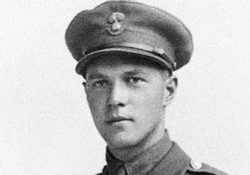CONN – Samuel Lewis Honey was born Feb. 9, 1894 in Conn, to parents Reverand George Edward Honey and Metta Blaisdell.
Honey was the eldest of the couple’s seven children.
Honey’s father served in several methodist churches in and around Conn. Much like other clergymen’s families, Honey and his siblings moved at frequent intervals throughout their childhood.
In his early life, Honey, despite being a diligent student, found time to indulge in hobbies such as sports, photography and music.
Honey attended school in Drayton until 1908 when his father was transferred to Princeton, Oxford County.
Honey then attended the Princeton Continuation School, which he graduated from in 1910.
After graduation, Honey set his sights on education, teaching at the Six Nations Reserve near Brantford and a school near Drumbo where the previous teacher had fled due to stubborn and unruly students.
However, Honey accepted the challenge and on account of his success was allowed to enter teachers’ college at a young age.
Honey enrolled at the Normal School in London in autumn of 1911 and graduated the following June with a public school teaching certificate.
The young teacher then went on to teach at the Londesborough school in Western Huron County, before resigning to take his senior matriculation (a certificate awarded to a high school graduate in Canada for successfully completing at a high school a year of additional studies of college grade) at the Walkerton High school.
He then went on to complete a course as a cadet instructor before returning to teaching in Whitchurch Township in York County.
He then planned to enroll at Victoria College in Toronto to receive his arts degree. However this was brought to an end by his enlistment in 1915 in Walkerton with the 34th Infantry Battalion.
The now young solider left for Devonport England on Oct. 31, 1915, where as an acting sergeant, he was chosen to partake in special courses in physical training and bayonet (a steel blade attached to the muzzle of a rifle used for hand-to-hand combat) fighting.
In August 1915, Honey was officially ranked as a sergeant by the 78th Infantry Battalion, part of the 4th division, and embarked on his journey to France on Aug. 12.
On Feb. 22, 1917, Honey was awarded the military medal for gallantry during a raid on German trenches.
Part of Honey’s award citation read, “He did most excellent work in clearing an enemy’s communication trench and establishing a block in spite of heavy opposition.
“He personally covered the withdrawal of his own and another squad under a very heavy grenade fire.”
Despite this, Honey remained humble and wrote to his family, “I think the rest of the party deserved recognition as much as I did … what I did, didn’t amount to much.”
The young solider was then awarded the Distinguished Conduct Medal for gallant leadership during the battle of Vimy Ridge in April, after his platoon commander had been wounded.
Honey assumed command, leading his party forward despite enemy fire, until he was compelled by casualties to dig in. Honey held his position for three days, setting an encouraging example for the rest of his party.
After Vimy Ridge Honey was recommended for a commission.
In early May he became an instructor at Bramshott pending the opening in July of the officers’ training course at Bexhill.
Honey rejoined his unit as a lieutenant on Oct. 14, 1917.
In August of 1918 the Canadian Corps was given the task of dislodging the enemy from a maze of defensive
positions considered to be almost impenetrable.
Through a series of determined attacks, the Canadians pierced the first three systems during the latter part of August and early September. On Sept. 27, the Canadians crossed the Canal du Nord, overran the heavily fortified German positions in Bois de Bourlon.
It was during this operation that Honey was awarded the Victoria Cross.
After all of the other officers of his company had become casualties, Honey took command and reorganized his party under fire, continuing the advance and gaining the objective.
Honey, finding that his company was suffering casualties from enfilade machine-gun fire, located the machine-gun nest and rushed it single-handed, capturing the guns along with 10 prisoners.
After fighting off four counter-attacks Honey went out alone after dark, located a German post, and took a party to capture it.
On Oct. 29, Honey led his company against a strong enemy position. Honey died of wounds received on the last day of the 78th’s attack.
After his death, Honey’s commanding officer wrote to the young soldiers family saying, “Nowhere have I seen such gallant work as this boy of yours displayed … he was the first to reach the final objective during the first day and throughout the days that followed he was an example of grit and determination that was the talk of the whole command.
“The men idolized him, and as they bore him by me that morning there was a tenderness in their care that only strong men can show.”
The young solider was buried in the Quéant Communal Cemetery British Extension France.
In accordance with his parents’ wishes, there was no investiture of his Victoria Cross. A plaque in Honey’s honour was unveiled by the Archaeological and Historic Sites Board of Ontario beside Westcott United Church, Conn, in 1964.
The family presented his medals without fanfare to the Canadian War Museum in 1975.
To read more about Lieutenant Lewis Honey visit biographi.ca/en/bio/honey_samuel_lewis or veterans.gc.ca.




